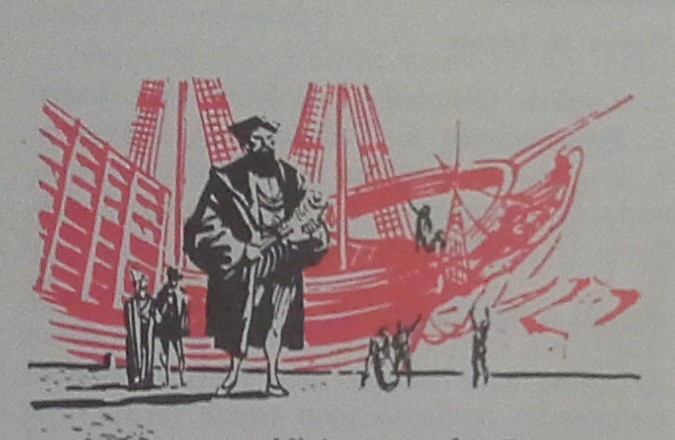Visitors to the Portuguese city of Lisbon, on a certain day in 1499, would have found the people in a holiday mood. Groups of townsmen who gathered here and there talked excitedly about the arrival of two ships and there was good reason. In the two years since these vessels had sailed down the river and slipped out of sight, they had completed the first trip from Europe around Africa to India and back. Such an event indeed deserved to be celebrated. Not only had the fearless captain of this expedition, Vasco da Gama, performed a great feat of navigation, but he had brought back spices and other goods worth 60 times the cost of his voyage.
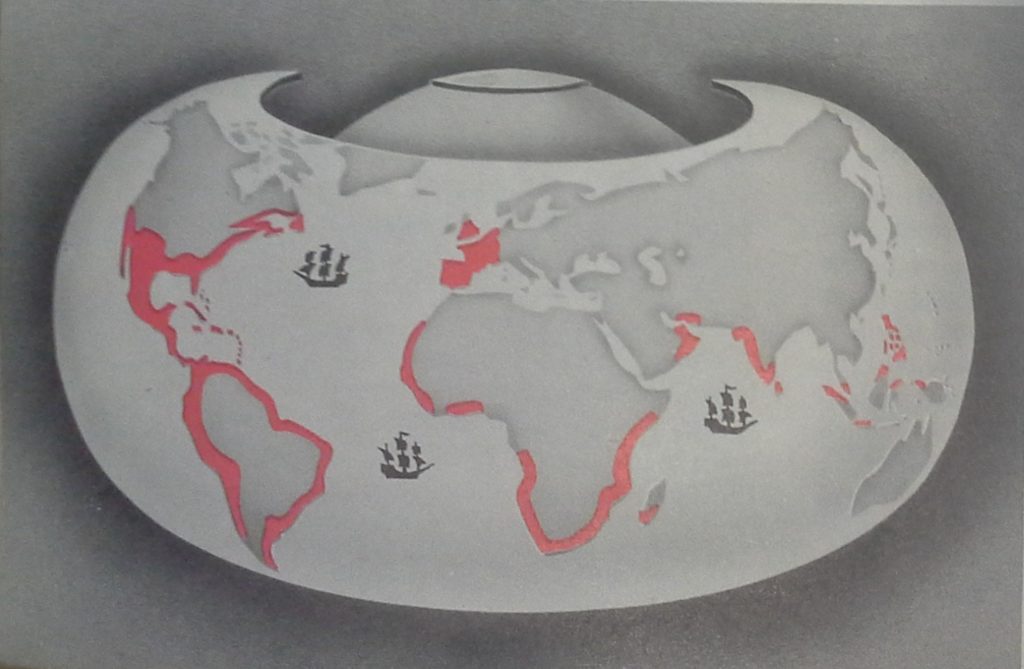
No wonder the people shouted. No wonder King John of Portugal rubbed his hands with glee and heaped honours on da Gama. For here, reasoned King John, lay the key to power and prosperity. Suppose each Portuguese ship returned laden with goods worth 60 times the cost of its voyage. Portugal quickly would become rich and powerful. How much better off he was, the king thought, than if he had listened to Columbus! That man had pestered him for years to provide the ships, money and men to sail westward across the Atlantic to India. To be sure, Columbus had finally obtained backing from the monarchs of Spain, Ferdinand and Isabella. What had he accomplished? For the most part, all he had found was a tropical wilderness peopled with savages and he had brought back little to compare with the rich cargoes in the holds of da Gama’s vessels.
Yes, in 1499 it looked as if little Portugal would get ahead of all other European countries in the race for wealth and power. Several years passed before other voyages across the Atlantic proved that there were opportunities and wealth in the New World as well as in the East Indies. As a result of all these expeditions, European nations during the next 200 years helped themselves to parts of the New World and the Far East. Chief among these nations were Spain, France, England, Portugal and Holland. We find answers to the following questions:
1. What led to the discovery of new routes and the exploration of unknown lands?
2. How did Spain lead the way in exploring and settling the New World?
3. Where did other European nations seek overseas trade and colonies?
4. How did overseas possessions affect Europe?
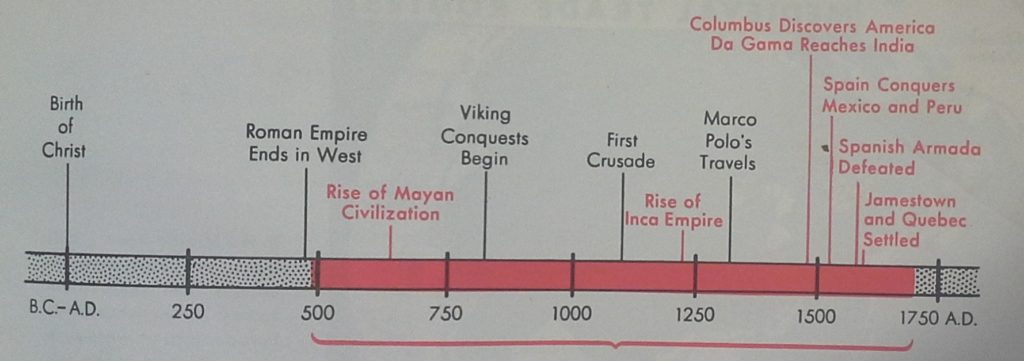
1. What Led to the Discovery of New Routes and the Exploration of Unknown lands?
People living today realize that tremendous changes can occur in a very short time. Within a single lifetime, for example, the airplane, radio, television and the threat of nuclear bombs have become a part of our living. Knowledge of science and medicine has increased with breath-taking speed, but we must not forget that men of other ages have experienced periods of far-reaching changes, too. A European who lived from 1475 to 1525, for example, would have lived at a time when undreamed-of continents were discovered and the size of the known world was doubled. He would have heard strange names and learned of faraway places.
Uneducuted Europeans held queer ideas of geography. Even in the 1400’s, most Europeans had ideas about the world that seem very odd to us today. They thought the earth was a flat, plate-shaped plain. In the centre, they argued, was Jerusalem, because the Holy City had to be in the centre. Around the outer-edge of this disc or plate, according to these people, was the ocean. If ships sailed too far out into it, either they would be destroyed by great sea monsters or they would fall over the edge of the earth.
What maps there were in those days showed the Mediterranean and the regions surrounding it fairly accurately. However, these maps furnished only vague ideas of Africa south of the Sahara, of Asia east of Persia, or of the northern and eastern portions of Europe.
Strange stories added to the confusion. There was the yarn about Prester John, a rich Christian king who ruled somewhere in Asia or Africa, just where, no one was sure. Rumors of apes in central Africa reached Europe in the form of weird stories about humans with dogs’ heads.
Some Europeans had sounder ideas about the world. People who had had sufficient schooling did not believe such nonsense about sea monsters, dog-headed men, or a flat earth. They knew that the ancient Greeks had reasoned that the world was round and had estimated its circumference. To these educated Europeans the idea of trying to reach India or China by sailing westward from Europe made sense.

In the Middle Ages, goods from the East reached Europe over these main routes. From what three European cities were such goods shipped to the rest of Europe?
A few Europeans had also come directly in contact with distant parts of the world. One of these was Marco Polo. Other Europeans had dealt with Arab traders who were fairly well acquainted with India, with the eastern coast of Africa and with lands north of the Indian Ocean. Also in northern Europe stories passed from father to son about the bold Vikings who had visited Greenland and lands still farther to the west where wild grapes abounded and there were vast forests.
Desire for new trade routes brought about the age of discoveries. Tales of travelers undoubtedly fascinated Europeans, but do not fully explain why a burst of exploration took place in the late 1400’s. The real cause of this activity was a desire to share in the rich trade with the Orient. The Crusades had stimulated a new interest in the products of the East. If you look at the map, you can trace the land and water routes which had developed between the eastern Mediterranean and China, India and the Spice Islands in the Far East. Cities in the eastern Mediterranean region served as market places where European and Arab merchants met to exchange their goods. Products from the Orient were then shipped to such cities as Genoa and Venice in Italy and Marseilles in southern France and thence to other parts of Europe.
Businessmen in the three cities just named grew wealthy from the high prices they got for luxuries from the East. If you were a merchant in Portugal or Spain in the 1400’s, you would undoubtedly want your share in this profitable trade. Using the existing trade routes would not be possible because the Mediterranean cities were able to monopolize or control this trade. So you would have to find some other way to get Oriental goods. Maybe it was possible to reach India by sea. If so, then you could bring back more goods at less cost and outsell the merchants of Venice and Genoa, but where was this all-water route? Nobody knew.
Prince Henry the Navigator did much to encourage exploration. In the early 1400’s, Prince Henry of Portugal sought an answer to this question. Prince Henry devoted himself to training and equipping explorers. He brought together the ablest sea captains, geographers and map makers that he could find. He collected maps, records of voyages and navigation instruments such as compasses and astrolabes. He studied how to build better ships. Then, on the southernmost tip of Portugal, Prince Henry the Navigator opened a school for the leaders of his many expeditions.
Portuguese sea captains searched for a water route to the East. Beginning in the early 1400’s, Portuguese sea captains sailed southward along the west coast of Africa. Each year these hardy explorers went still a little farther. Finally Bartholomew Dias, his ship driven out of sight of land and far to the south by a storm, sighted land again. The land now however, was to the west of his ship instead of the east! This could mean only one thing; he had sailed around Africa’s southern tip without knowing it.
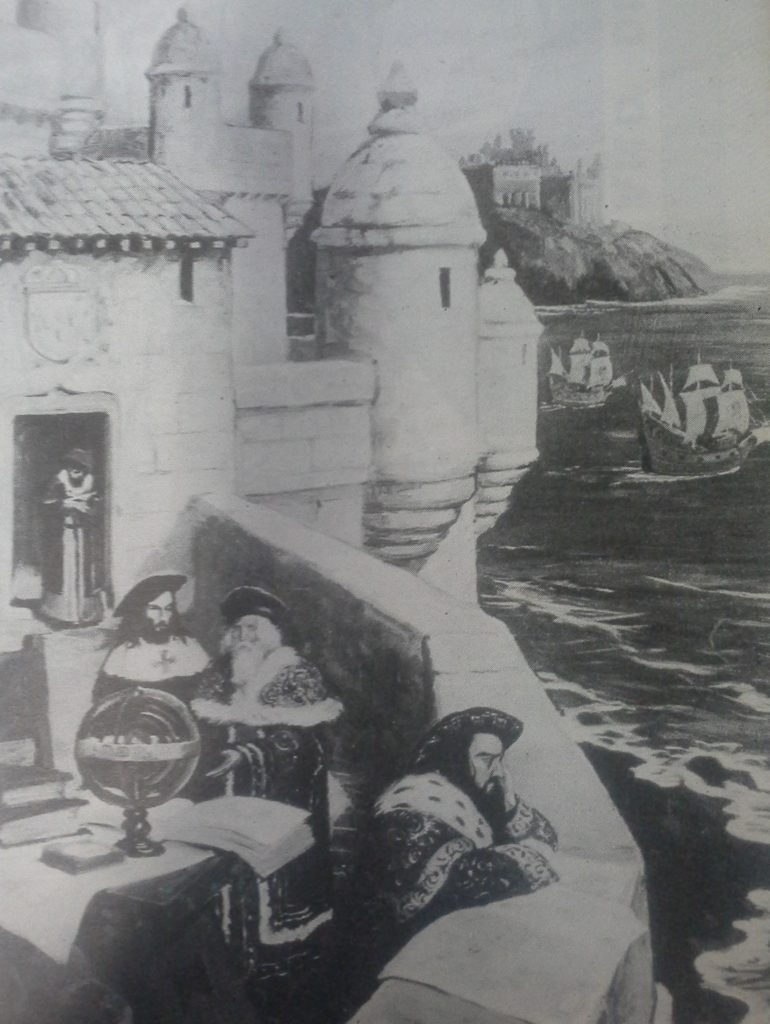
Prince Henry the Navigator dreams of distant lands, in this painting. Henry made no explorations himself, but greatly encouraged those who did. Geographers and navigators studied at his castle.
Dias named a cape near the southern tip of Africa the Cape of Storms. When the Portuguese king heard Dias’ report, he changed the name to the Cape of Good Hope — the route to the riches of the East. You will find that name to this day on maps of Africa. A few years later, following the same route but pushing far beyond the Cape of Good Hope, Vasco da Gama made his famous voyage. Portugal had discovered a way to the wealth of the East by skirting Africa’s west and east coasts.
Columbus led the way across the Atlantic. We learned that some people believed it possible to reach Asia by sailing due west. Yet for years Christopher Columbus, a navigator from Genoa, Italy, met with scornful refusals in his efforts to get the men, money and ships needed to test this idea. Finally he persuaded the King and Queen of Spain, Ferdinand and Isabella, to finance an expedition. His little fleet set sail from Palos, Spain, in August 1492.
Day after day the tiny vessels beat their way westward with no sight of land. The crew began to grumble and Columbus himself realized that his estimate of distance must be wrong. Yet the valiant navigator stuck to his course. Finally on October 12, 1492 an island was sighted which Columbus called San Salvador. After visiting several other islands Columbus returned to Spain, bringing word that he had found the long-sought westward route from Europe to Asia. The following portions of his report of this voyage show how confident Columbus was of the importance of his discovery:
Sir, As I know that you will be pleased at the great victory with which Our Lord has crowned my voyage, I write this to you, from which you will learn how in 33 days I passed from the Canary Islands to the Indies with the fleet which the most illustrious King and Queen, our sovereigns, gave to me. And there I found very many islands filled with people innumerable, and of them all I have taken possession for their Highnesses. . . . When I reached Juana, (meaning modern “Cuba”) I followed its coast to the westward, and I found it to be so extensive that I thought it must be the mainland, the province of Catayo (meaning “Cathay” or “China”). And since there were neither towns nor villages on the seashore, but only small hamlets . . . I went forward on the same course, thinking that I should not fail to find great cities and towns. . . . I sent two men inland to learn if there were a king or great cities. They traveled three days’ journey and found an infinity of small hamlets . . . but nothing of importance, For this reason, they returned. . . . I saw another island, to which I at once gave the name Espaniola. This island and all the others are very fertile. . . . There are six or eight kinds of palm . . . a wonder to behold. . . . So are the other trees and fruits and plants. In it are marvelous pine groves, and there are very many large tracts of cultivatable lands, and there is honey, and there are birds of many kinds and fruits in great diversity . . . and the population is without number. . . . I have found rhubarb and cinnamon, and I shall find a thousand other things of value, which the people whom I have left there will have discovered. . . .
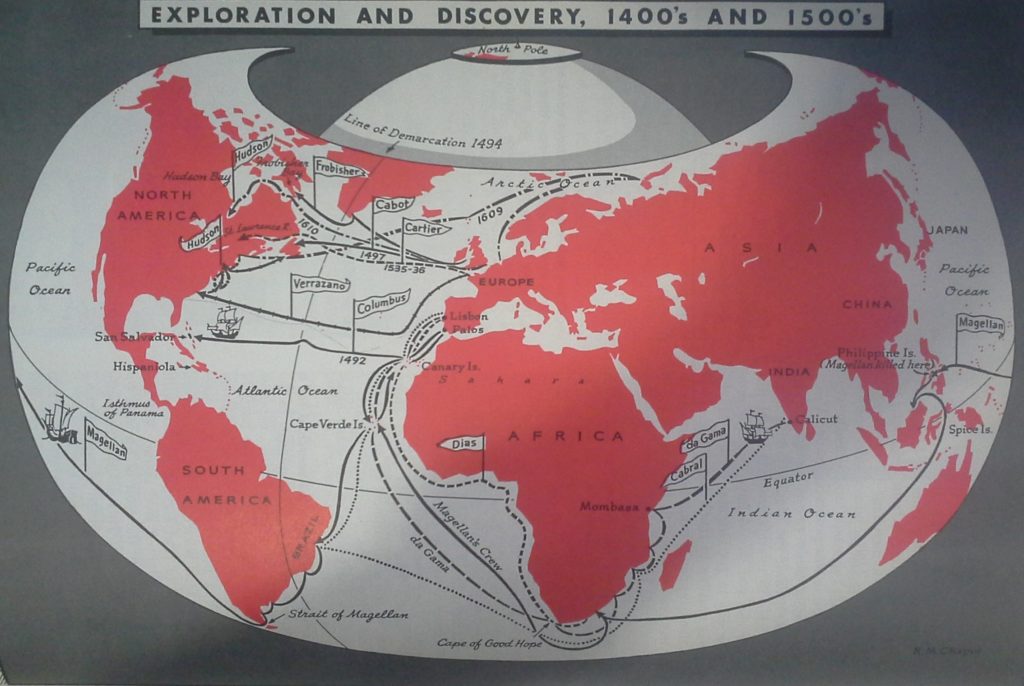
Columbus never realized he had discovered a ”New World.” Within the next dozen years, Columbus made three more voyages across the Atlantic, always seeking the mainland of Asia. He did find more islands and part of the northeast coast of South America. The great Admiral of the Ocean Sea, as he was called, never realized that he had discovered an entirely new part of the world. Columbus died in 1506, largely ignored but still believing that the lands he had touched were the outlying portions of Asia.
Cabot and Cabral visited other parts of the New World. After Columbus had pointed the way by his famous voyage in 1492, other daring explorers followed. Their expeditions provided further knowledge of the New World Columbus had discovered. In 1497 another Italian, John Cabot, sailing in the service of the king of England, discovered a new found land which to this day we call Newfoundland. The codfish that swam in the cold, shallow waters around Newfoundland make this big island off Canada’s eastern coast one of the world’s great fishing centres. Cabot’s discovery of Newfoundland and the fact that he probably visited the mainland of North America, gave England a foothold in the New World.
Three years later, in 1500, a Portuguese captain named Cabral set out from Portugal with thirteen ships. He meant to follow Da Gama’s route to India, but strong winds blew Cabral’s fleet from the west coast of Africa to the east coast of the South American country we call Brazil. Promptly Cabral claimed Brazil for Portugal. Then he turned eastward again, rounding Africa and sailing on to India. Years later Portuguese colonists in large numbers settled in Brazil. This is the reason why Portuguese remains to this day the language most widely used in that country.
European rulers laid rival claims to the newly discovered lands. You may wonder why European explorers claimed the lands and peoples they found as the property of their kings. European rulers of that day seized such areas to increase their wealth and power. It never occurred to them that primitive people living in faraway lands might have rights, too. Often the claims of one king clashed with the claims of another.
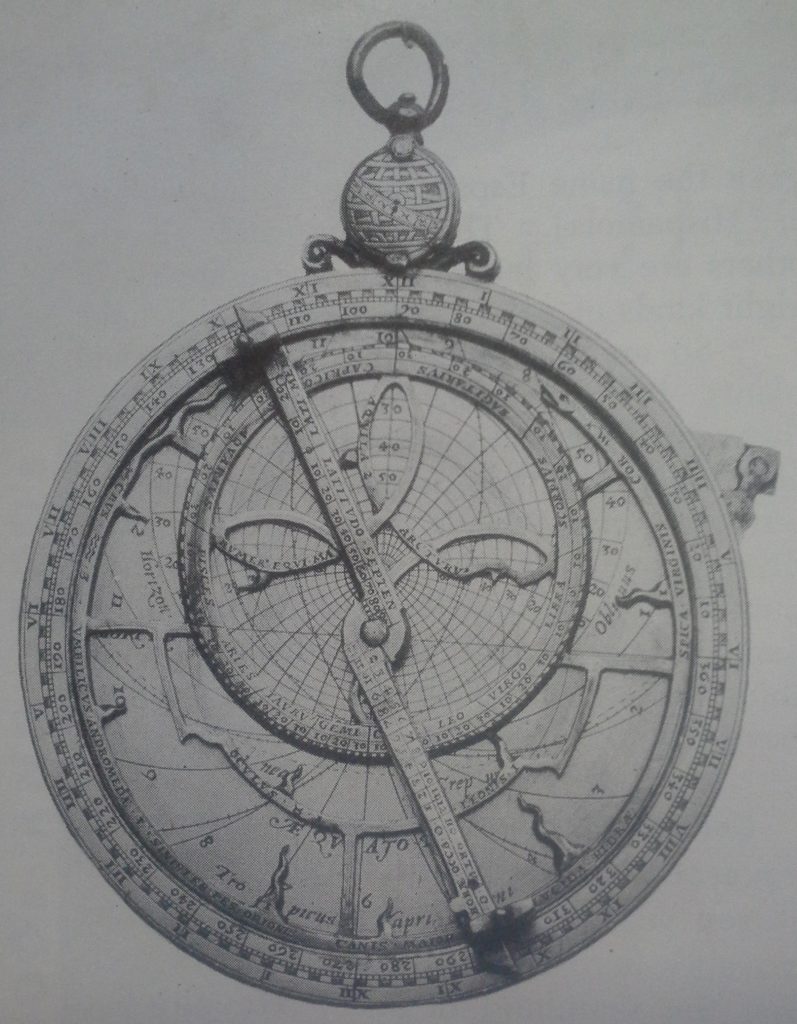
A clash over “who owned what” developed between Spain and Portugal just as soon as Columbus discovered America. In 1493 the Pope declared all newly discovered lands more than 100 leagues (300 miles) west of the Cape Verde Islands should go to Spain and all east of that imaginary line should belong to Portugal. A year later this so-called Demarcation Line was shifted further west by a treaty.
The rulers of England and France, however, refused to accept this arrangement. They declared that they alone had rights to the parts of North America which their explorers had visited. Later England claimed all of North America because Cabot had visited its eastern tip. Such claims and counterclaims led to many quarrels among the greedy rulers of Europe.
Magellan’s ship sailed around the world. The explorations which followed Columbus’ voyage taught the world new facts of geography. In 1513 a Spanish adventurer, Balboa and his little band of followers struggled across the Isthmus of Panama. They were the first white men to gaze upon the vast Pacific Ocean from the shores of America. Even more important was the historic voyage of Ferdinand Magellan.
On the map, find the Strait of Magellan near the southern tip of South America. Magellan discovered this narrow, winding passageway in 1520. Into it his little ships fought their way against storms and swiftly flowing tides; and then they sailed out onto the broad Pacific Ocean. Carried by favourable currents and winds, Magellan sailed for thousands of miles until he reached the Philippine Islands. There, in a quarrel with natives, Magellan was killed, but not before he had claimed these islands for the Spanish king. In 1522, three years after the fleet had set out from Spain, a single ship limped hack to its home port. That ship was the first ever to sail around the world.
This great voyage proved three things: (1) The world is round. (2) Asia can be reached by sailing westward across the Atlantic and Pacific Oceans by way of the Strait of Magellan. (3) The distance across the Pacific is far greater than across the Atlantic.
However, who wanted to spend two or three years sailing from Europe to Asia? Was there a short cut through North and South America? Some explorers decided to find out.
The search for a shorter route to the East continued. Explorers believed that the shortest route between Europe and the East could be found by sailing north-west across the Atlantic. Many set out to find this route and those who lived to tell of their voyages provided valuable information. In 1524 an Italian, Verrazano, was sent out by the French king. Verrazano sailed along the Atlantic coast of North America, but he found no short cut to the Pacific Ocean and Asia. Ten years later a Frenchman, Jacques Cartier, sailed into the mouth of the mighty St. Lawrence River. Shallow rapids which Cartier discovered farther up the river proved that this was not a passage to the East. An English seaman named Martin Frobisher made three voyages into the frigid Arctic in search of a way around northern Canada to Asia. Frobisher also failed.
In 1609 Henry Hudson, an Englishman employed by the Dutch, discovered the Hudson River. At first he sailed eagerly up its broad and tranquil waters, hoping that here was the beginning of the long sought passageway to Asia, but as the river narrowed, his hopes were dashed. The next year, the undaunted Hudson set out on a new voyage far to the north. This time Hudson met with disaster, for he and his young son were set adrift by a rebellious crew and vanished in Hudson Bay in northern Canada. Many another sailor-explorer paid for his zeal with his life. Not until 1906 did a ship, captained by the great Norwegian explorer Roald Amundsen, go through the Northwest Passage from the Atlantic to the Pacific. The passage is there, but is so clogged with ice as to be worthless for navigation.
2. How Did Spain lead the Way in Exploring and Settling the New World?
Modern Latin America shows both Indian and European influences. The term Latin America refers to Cuba, Hispaniola and other West Indian islands; to Mexico and Central America; and to South America. The name Latin America is appropriate because the Spanish and Portuguese languages, which are spoken throughout most of this vast area, are descended from the Latin language.
The New World had been peopled long centuries before the appearance of Europeans. Many of the natives whom Columbus called Indians still followed Stone Age ways of living, but remains which archeologists have studied, as well as the stories of early European explorers, indicate that some groups had developed a high level of culture. This progress seems to have been made largely without borrowing from civilizations in other parts of the world.
The Mayas developed an extraordinary civilization. The oldest and most advanced civilization was that of the Mayas. Long before the Europeans arrived, the Mayas had enjoyed two periods of greatness, one in what is now Guatemala (in Central America and a later one in the Yucatan peninsula of Mexico. The Mayas built beautiful cities like Chiehén Itzé, whose ruins amid the jungle tell us much about this ancient people.
The Mayas reached high levels in art and learning. They erected imposing buildings of stone and mortar. Their most remarkable structures were pyramids built several stories high in a series of great steps and topped by magnificent temples. These temples and other public buildings were decorated with sculptured figures of gods and animals or with carvings of battle scenes. The sculptures and carvings were extremely well done, considering the fact that the Mayas lacked iron tools. Other works of art included vases, jewelry and fine weaving. The Mayas also had considerable knowledge of astronomy and built observatories to aid in this study. They developed a calendar more accurate than the one used in Europe at the time of the discoveries. They probably developed a number system, including the use of zero, earlier than the Hindus. They used a form of picture writing.
Mayan people were divided into several classes. Most powerful were the nobles and the priests who presided over the worship of many gods. Mayan merchants carried goods long distances over stonepaved roads or by sea. Columbus reported meeting some of them in a large canopied canoe off the coast of Central America on one of his voyages to the New World. Most of the Mayas were farmers, although there were also numerous craftsmen.
The Mayas developed a city-state system of government somewhat like that of the ancient Greeks. As in the case of the Greeks, this system helped to bring about their downfall. Wars between different city-states weakened them and they were finally conquered by warlike invaders from the north, called Toltecs.
The Aztecs built a great empire in Mexico. Other groups in Latin America reached high levels of civilization, too. One of them was the Aztecs, who settled in the Valley of Mexico about 1200 AD. The primitive, warlike Aztecs subdued the surrounding tribes and forced them to pay tribute. At its height the Aztec empire extended from the Gulf of Mexico to the Pacific. The principal city, Tenochtitlan (now Mexico City), was a marvel of beauty and engineering skill.
The Aztecs were not merely successful warriors. They also developed a well-organized government. Their ruler was assisted by a council of chiefs and a large body of officials. Law courts handed out severe punishments to offenders, rich and poor alike.
The Aztecs absorbed much from civiIizations such as the Toltec and Mayan. They built splendid buildings and irrigation systems. They produced fine sculpture, paintings, pottery, cloth and metal work. They also developed a thriving trade. Like the Mayas, they possessed an accurate calendar and employed picture writing and like the Mayas, they worshiped the sun and other forces of nature. Unhappily their religion called for human sacrifices to appease their gods and tens of thousands met their death at the altar atop the great pyramid of Tenochtitlan.
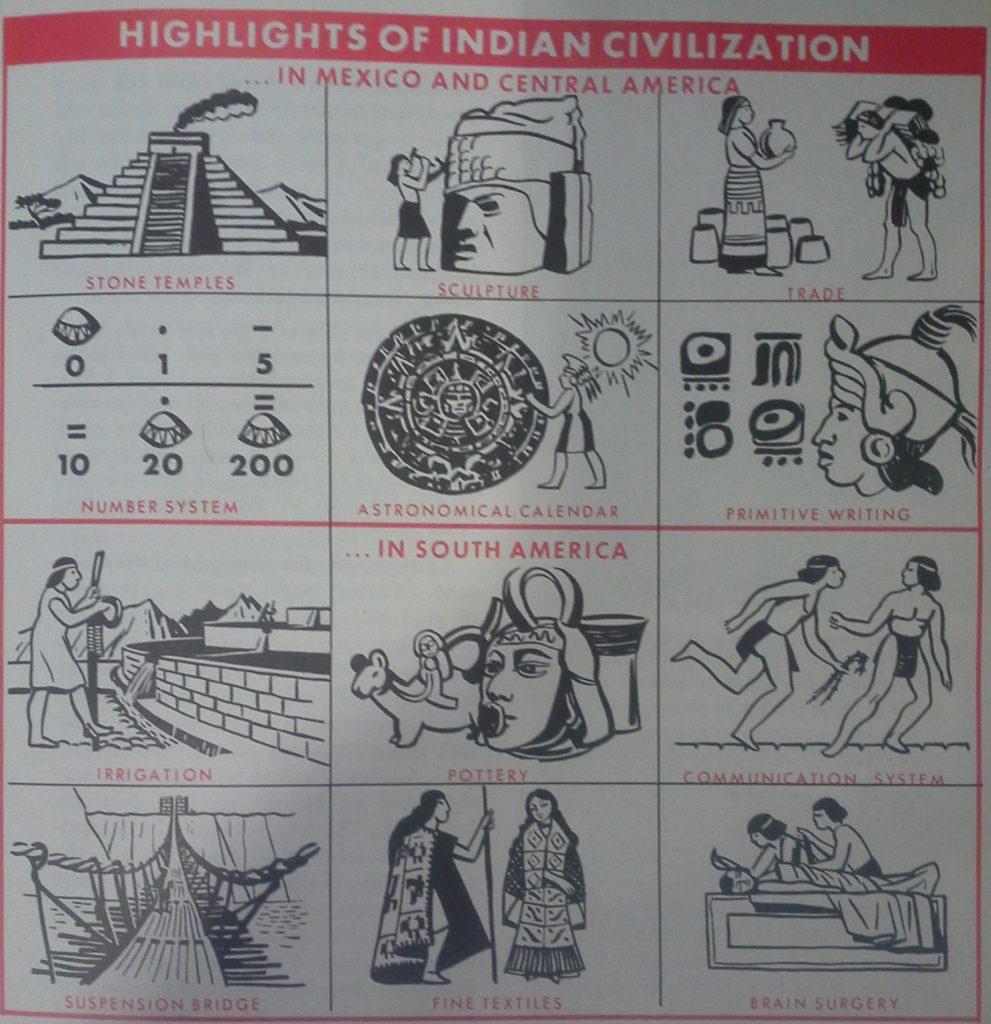
The Incas of Peru developed the highest civilization in South America. Far to the south, in the highlands of what is now Peru, dwelt another highly civilized people. These people are commonly referred to by the name of their exalted ruler, the Supreme Inca, who was supposed to be descended from the Sun God.
The Incas had conquered so many other tribes that they ruled a large empire. This they governed efficiently. Subject peoples, for example, were not enslaved but were taught Inca ways. A network of well-paved roads equipped with rest-houses made travel easy. A common language was spoken throughout the empire. Property belonged to the community and the lives of the people were closely supervised by a vast body of public officials.
In many ways the Incas made great progress. The Incas developed irrigation systems and used fertilizers to improve their crops. They produced pottery, cloth and ornaments of many kinds. They excelled in surgery.
In other respects, however, the Incas were backward. They developed no written language. Like the Mayas and the Aztecs. the Incas worshipped the Sun God, to which they offered both animal and human sacrifices.
Important as were the Aztec and Inca achievements, they did not stand alone. In many parts of Central and South America lived other Indian peoples who approached, if they did not equal, the civilizations of the Aztecs and Incas.
The Spaniards first settled Hispaniola. Europeans did not come in contact with the Aztecs or the Incas for several years after the New World was discovered. Columbus chose the island of Hispaniola for Spain’s New World headquarters. There Spanish settlers went in considerable numbers. There they built the first cathedral in the New World. From Hispaniola Spanish explorers and adventurers sailed to nearby islands and to the mainland of North and South America.
Greatest of the Spanish adventurers wus Cortés. Hernando Cortés was a young soldier-explorer who had become bored with life as a plantation owner in the West Indies. “I came to get gold, not to till the soil like a peasant,” Cortés complained. Finally there came an opportunity to command an expedition to Mexico. This was the chance to win gold and glory. Said Cortes to his 500 men as the expedition was about to sail to Mexico:
I hold out to you a glorious prize, but it is to be won by ceaseless toil! Great things are won by great exertions. . . . If I have laboured hard and staked my all on this undertaking, it is for the love of that fame which is the noblest reward of man. But if any of you desire riches more . . . I will make you masters of such as our countrymen have never dreamed of!
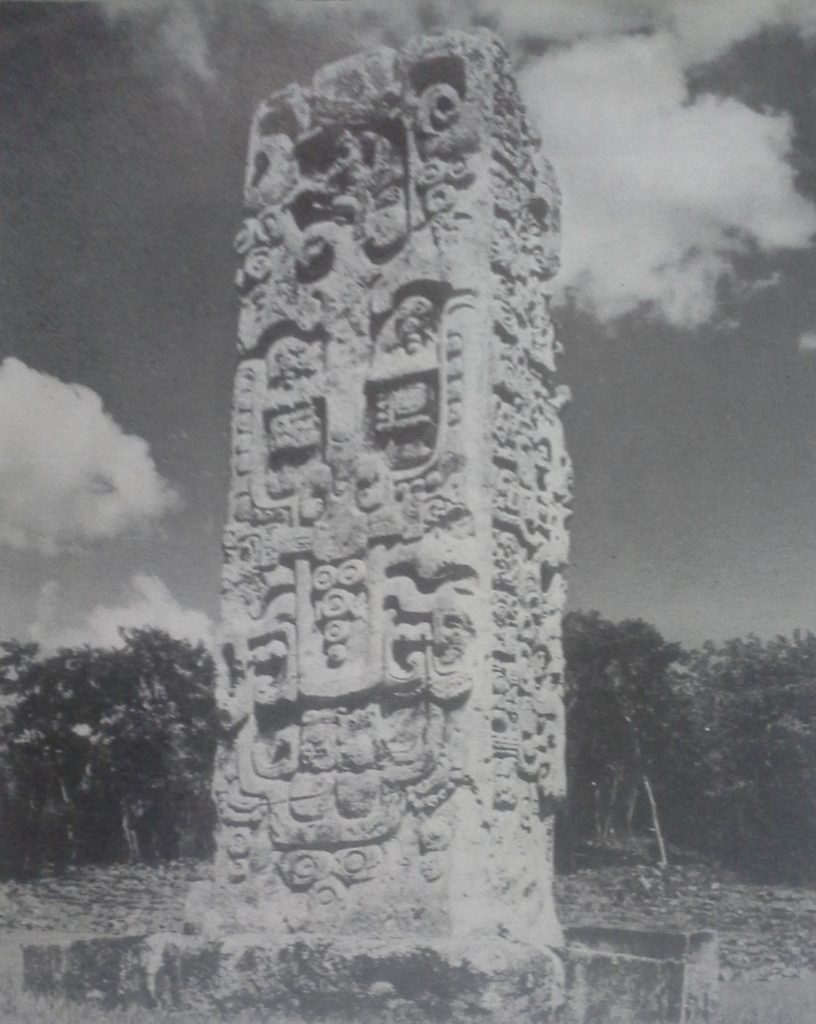
Cortés began the conquest of the mainland. Cortes made good his promises of gala and glory, but he and his men won Mexico and its wealth only after the “ceaseless toil” and “great exertions” he had promised. In 1519 they landed on the coast near what is now Veracruz. After destroying his ships so none could turn back, Cortes marched his little army into the heart of Mexico and up onto the tableland. There on an island in the middle of a lake stood Tenochtitlan, the capital city of the Aztec Indians, who ruled a large part of Mexico. There also were temples and palaces worthy of ancient Egypt. The Aztecs invited the Spaniards to enter their city, because they had never seen white men, nor metal armour, nor guns and cannon, nor horses, the Aztecs believed the strangers must be gods. These “gods” must be treated royally, so Moctezuma, the Aztec ruler, commanded that a palace be made ready for the Spaniards.
Into the city, over a causeway (raised road) that led from the mainland to the island, moved the Spanish column. Sunlight flashed on the armour of the warriors and glinted on their guns and cannon. White-faced, black-bearded strangers looked down from their horses upon the crowds of awe-struck Aztecs.
A few days went by. Suddenly the Spaniards seized Moctezuma and announced that the Aztecs must pay a huge ransom to free their ruler. The enraged Aztecs‘refused and fiercely attacked the Spaniards. Moctezurna was killed and the Spaniards suHered great losses in the retreat over the causeway to the mainland.
In the end Spanish discipline, cannon, guns, horsemen, and knowledge of the art of war prevailed. Aided by Indian tribes that had good reason to hate the Aztecs, the Spaniards became the sole lords of Mexico and Central America.
Pizarro conquered the Incas of Peru. In much the same manner as Cortés, anothex Spanish conqueror, Francisco Pizarro, became master of Peru and the neighbouring parts of South America. First Pizarro seized the Supreme Inca, the ruler of Peru and demanded an immense ransom in silver and gold. The Inca’s faithful subjects paid it by gathering gold and silver from all parts of the empire. Then Pizarro had the Supreme Inca put to death. Though Pizarro later was murdered by one of his own men, Spain held Peru. From its mines the Indians dug silver and gold which, like the Aztec treasure of Mexico, was sent to Spain. Lima, the city the Spaniards built in Peru, became the centre of Spanish rule in much of South America.
The Spanish set up a huge empire in the New World. The success of Cortes and Pizarro led other Spanish adventurers to seek treasure and glory. Among these was de Soto, who discovered the Mississippi River in 1541, and Coronado, who explored parts of what is now the southwestern United States. Spanish control was extended over the West Indies, Central America, a large part of South America and much of the southern portion of North America. The huge empire was divided into two parts, each ruled by a viceroy, or representative of the king of Spain, who acted as governor.
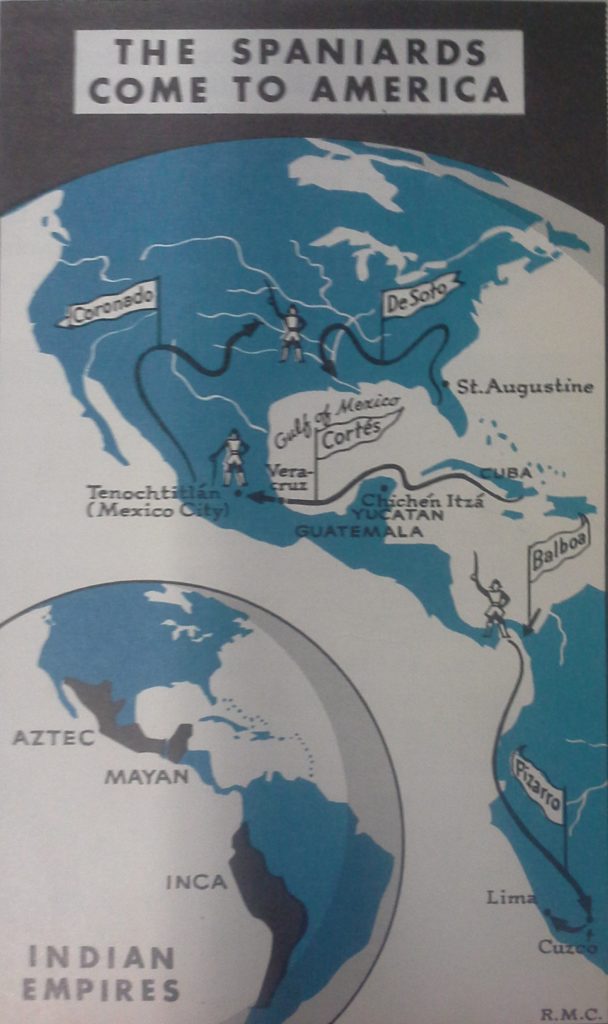
Despite the efforts of the Spanish government and the Church, the early Spanish settlers mistreated the conquered Indians. Indians were forced to labour in the mines and on the large estates. They did not work well when deprived of their freedom and many of them died. Later, in some tropical regions, Negro slaves were imported from Africa to do much of the heavy work. This fact accounts for the considerable number of Negroes in tropical Latin America today.
Churchmen played an important part in settling the New World. Not all Spanish settlers were soldiers of fortune who came to the New World for adventure or gold. Many Spanish priests and friars came to convent the Indians. These churchmen not only worked hard to spread Christianity; they tried to protect the lives and liberty of the Indians whom they had converted. The heroic Bishop Las Casas, for example, laboured for many years in Hispaniola and Mexico to aid the oppressed Indians. Through his efforts, the government in Spain forbade certain abuses. The earlier system of forced labour was gradually transformed into a less burdensome form of serfdom. In the mission schools the churchmen taught Indians such useful trades as carpentry and metalworking, as well as how to read and write.
The efforts of these devoted churchmen influenced the history. Many Americans have visited the Spanish missions built in our Southwest long ago by Indians under the direction of Spanish priests. In Texas, for example, the first of many such missions was opened in the late 1600’s. Twenty-one missions were established within the present state of California and others in New Mexico.
Ways of living changed. The coming of Europeans brought changes to Indian ways of living. Horses, which the Spaniards introduced in the New World, multiplied rapidly not only in Mexico but on the great plains of America and Argentina. Indians soon became accustomed to horses. The Spaniards also introduced grains, cattle and various fruits into the New World. From the Spaniards the Indians first learned the use of iron and steel weapons and implements. These were far superior to the flint arrowheads, stone hatchets and even the glass and copper knives of the Aztecs.
In spite of these changes, most Indians continued to follow simple ways of living. The Spaniards, however built up cities with government buildings, cathedrals and universities. Lima in Peru and Mexico City were good-sized cities by the 1600’s. In these cities a way of life grew up that in many respects resembled that in European cities of the time.
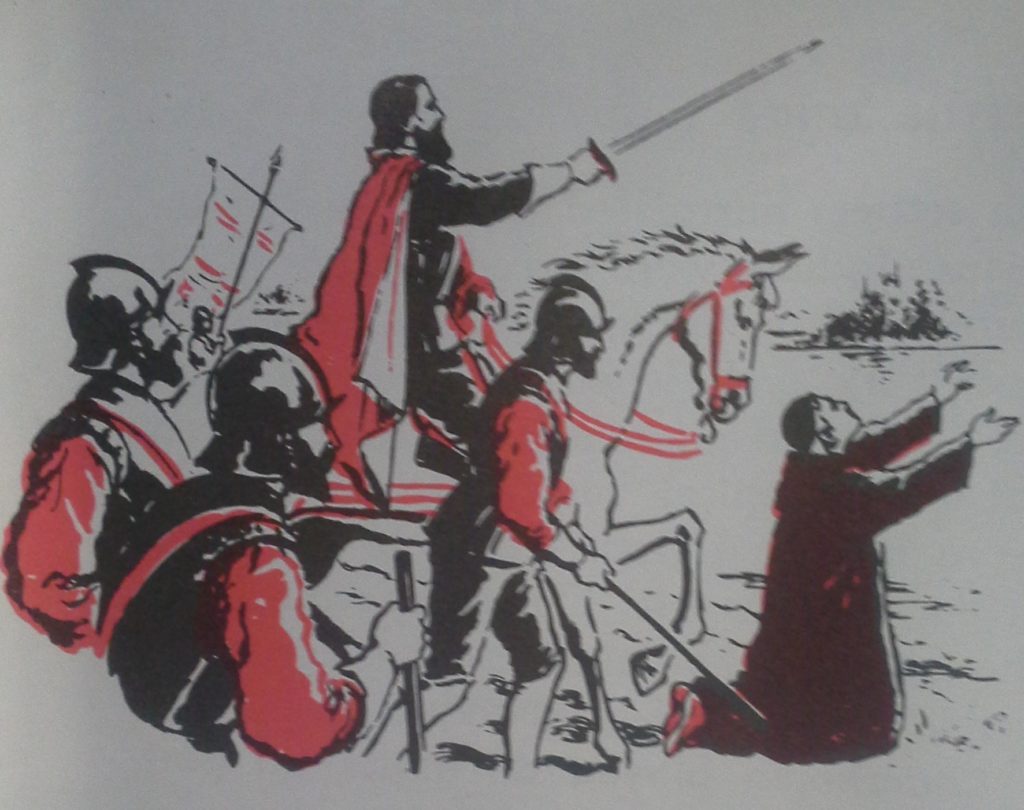
3. Where Did Other European Nations Seek Overseas Trade and Colonies?
Although the Spaniards took the lead in opening up the New World, they had no monopoly of the search for colonies and for greater trade opportunities. In the New World, for example, Portugal claimed Brazil as a result of Cabral’s discovery. Portuguese settlements in Brazil, however, grew much more slowly than Spanish settlements elsewhere in Latin America. Portugal, in fact, was more interested in developing a network of profitable trading posts in Africa and Asia than in colonizing the New World.
The Portuguese developed a thriving trade in Africa and Asia. As early as 1300 the Portuguese had opened up trading posts on the west coast of Africa. In the next 300 years they pushed farther down the west coast and then up the east coast of that continent. As they advanced, more trading posts appeared. Large parts of Africa, said the Portuguese, were their property, though little was done to colonize them. Portuguese traders, following the route charted by da Gama, also sailed to India and even to Japan. The Portuguese established trading posts in Asia and during the 1500’s controlled most of the profitable Far East trade.
The Portuguese lost much of their empire. Despite their swift rise to power and prosperity, Portugal and Spain were unable to retain their advantage. Portugal was the first to suffer. Eager to develop overseas trade, Portuguese merchants had borrowed heavily from bankers in other countries. Furthermore, they did not have enough ships to take care of their trade; so Portuguese merchants hired ships owned by men of other countries. Foreign banks charged the Portuguese high rates of interest on loans and shipowners of other countries charged them stiff freight rates. In short, Portugal overreached itself in trying to control an immense trade with three continents.
The chief blow to the Portuguese came in the late 1500’s when their country was annexed by their stronger neighbour Spain. Sixty years passed before Portugal shook off Spanish control. Meanwhile, Portuguese ports in Africa and the Far East were preyed upon by other nations, particularly the ambitious Dutch. Nevertheless the Portuguese managed to keep control of such points as Macao and Goa in Asia, large holdings in Africa and Brazil in South America.
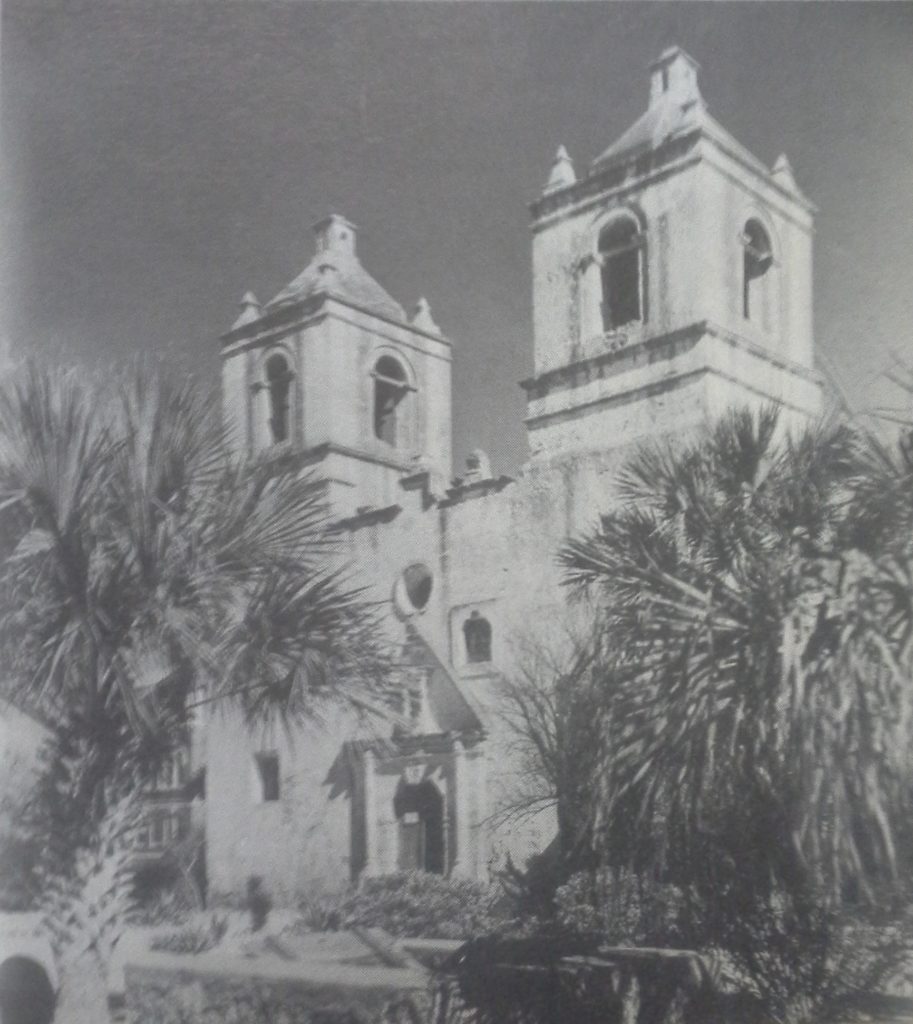
Spain’s power declined. Spain, too, had its troubles in the late 1500’s. Spain’s interest in the New World was chiefly in the gold and silver which it could obtain. Vast quantities of these precious metals from Mexico and Peru were shipped across the Atlantic, although daring sea raiders, chiefly English, attacked the treasure ships and even raided Spanish ports. The gold and silver actually did not make Spain rich. Some of it was used by Spain’s ambitious kings to carry on wars in Europe and because there was little manufacturing in Spain, much of the wealth from the New World was paid out to other European countries to buy goods. Moreover, the sudden increase in the gold and silver supply caused the value of these metals to decline. Prices went up and Spain suffered what today we call inflation. In other words, more money bought fewer goods.
Meanwhile the English raiders grew bolder. Led by Francis Drake, they entered the harbour of Cadiz, Spain, and destroyed a Spanish fleet. By this act of daring Drake boasted that he had “singed the King’s beard”. At last, Philip II of Spain decided that the time had come to strike a blow at England, the stronghold of Protestantism. He fitted out an immense fleet — 130 ships manned by 8000 sailors and carrying an army of about 20,000 men. In 1588 this huge Spanish fleet, ealled the Armada, set sail for England, but that little nation rallied bravely to resist attack. English seamen, in their easily handled swifter ships, inflicted heavy damage on the slow-moving Spanish vessels. Storms that swept the narrow English Channel and the seas surrounding the British Isles completed the destruction of a large part of the Spanish fleet. Though Spain continued to be an important European power for some time, the defeat of the Spanish Armada marked the beginning of its decline.
The Dutch won colonies and trade. The people of the Low Countries (modern Holland and Belgium) had long been great traders. Merchants traveling over land from the wealthy trading cities of the Mediterranean to northern Europe crossed this region. By the year 1500 the Low Countries were famed for bustling cities and towns, busy cloth industries and wealthy bankers, traders and shipowners. The hard-working people of the northern provinces (the Dutch), like the Phoenicians of old, turned to the sea for a living because their country was small and their population large. A good living they made, carrying goods by ship between northern and southern Europe.
In the 1500’s the Low Countries, of Netherlands, came under the control of Spain. It is sufficient to point out that after a long and bitter struggle the Dutch in the northern provinces won independence from their Spanish masters.
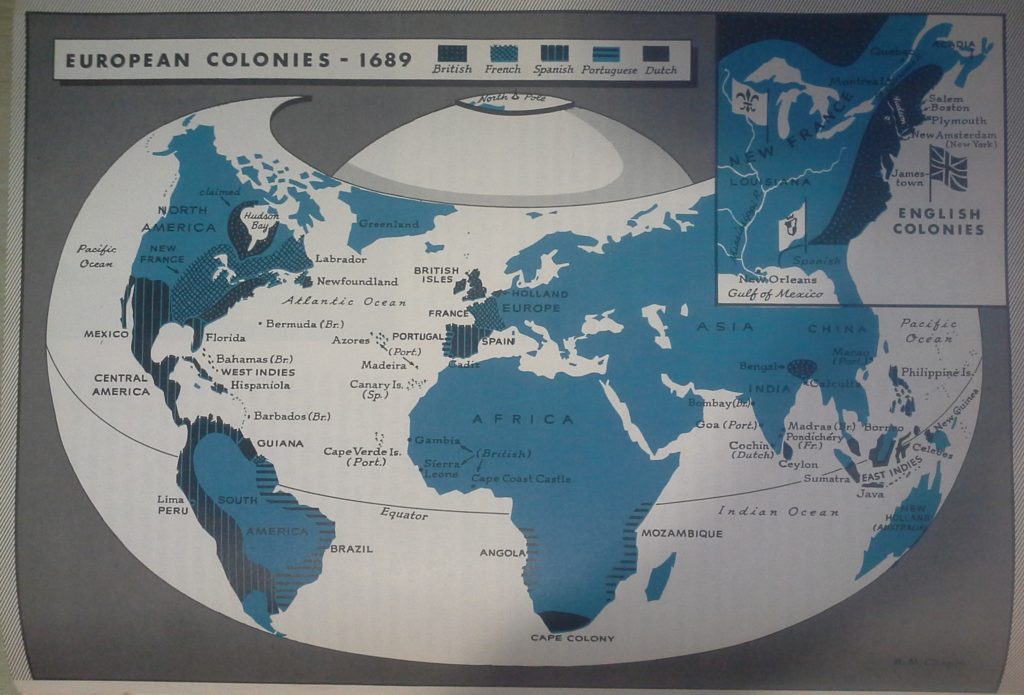
The newly independent Dutch profited from Spain’s conquest of Portugal and the blow to Spain’s sea power inflicted by the English in 1588. They took over much of the Portuguese trade with Africa and the Far East. They even helped themselves to some of Portugal’s colonies. They established settlements of their own in South America, Africa and the Far East Following the voyage of Henry Hudson, they founded New Amsterdam, which became New York City, in 1623. The Dutch also settled along the Hudson River and within the present states of New Jersey and Delaware. Although they lost New Amsterdam in 1664 to the English, the Dutch had better luck with other colonies, particularly the Dutch East Indies, off the southeast coast of Asia. Holland held the Dutch East Indies until World War II.
England and France, though starting late, pressed hard for colonies. In the 1500’s both France and England were too busy with problems of government and religion to bother with overseas exploration and settlement. In the early 1600’s the British and French made up for lost time. Opportunities overseas attracted traders seeking quick profits and farmers seeking plentiful land. There followed a wave of colonization in the New World and a spurt of trade with the East.
Trading companies encouraged English colonial ventures. Trading companies were responsible for the founding of several of the most important British colonies. A trading company, to use a modern term, was a corporation. A group of people with money to invest would put their funds together and outfit an expedition to open up trading posts in America, Africa, or Asia. Any profits would be distributed to the people who had put in money, according to the amount they had invested. Such people are called stockholders or shareholders. The trading posts might become settlements where furs or fish or lumber or spices could be exchanged for English-made goods. By this arrangement (1) shareholders received profits; (2) the people in England obtained the foreign products they wanted; and (3) inhabitants of the colonies received much-needed goods of many kinds manufactured in the mother country. Trading companies also provided the ships, food, and equipment without which many settlers would have been unable to leave England for a distant land.
The British gained a strong foothold in India. One of the most famous trading companies was the British East India Company. In 1603 a representative of this company arrived in India. His purpose was to make arrangements with the local rulers for trading rights. Five years went by before he was successful. By the later 1600’s, however, the British East India Company controlled most of the trade of northern India. It also had a firm hold over such cities as Bombay. The British East India Company not only carried on trade but exercised certain powers of government, such as issuing money and enforcing the law.
Englishmen began to think that the trade and riches of India would be all theirs. So you can readily understand how disturbed Englishmen were when news reached them that Frenchmen had opened up trading centers in parts of southern India. Bv 1689 it was clear that England and France would some day light it out for control of India and its rich trade.
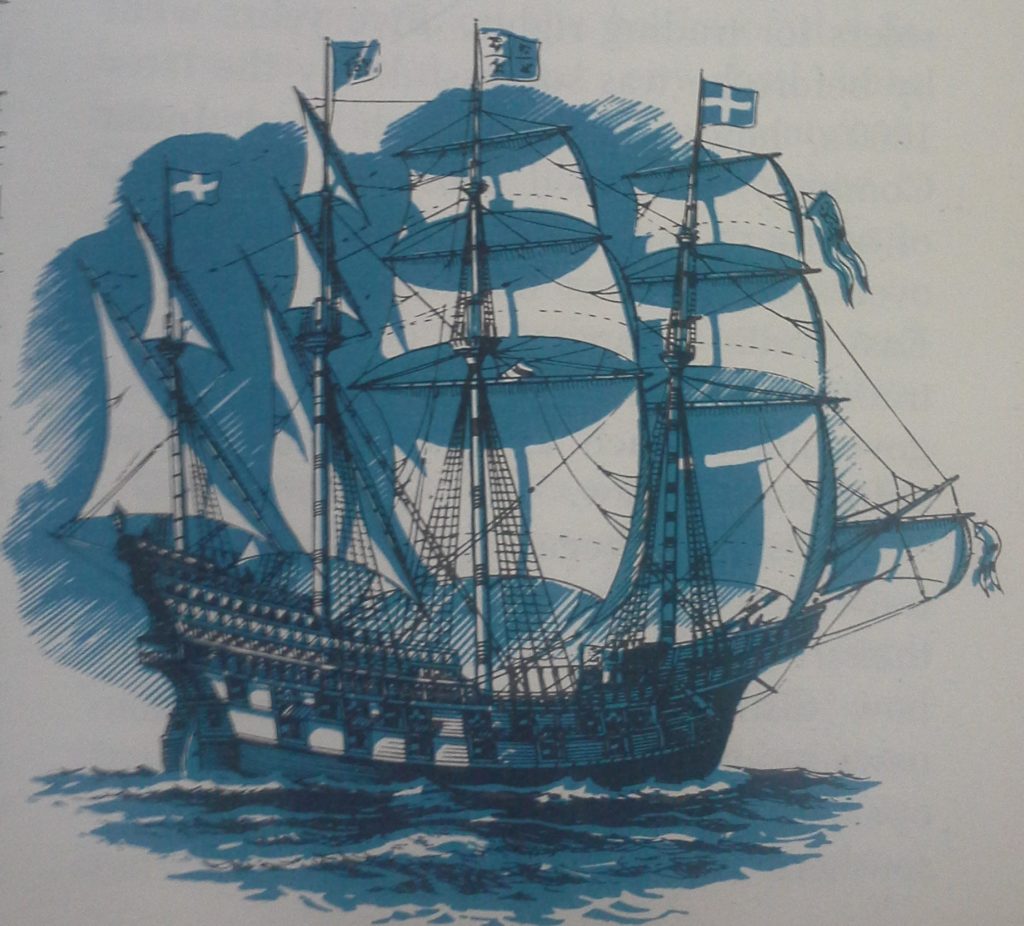
Thirteen English colonies were established in what became the United States. Most of the colonizing activity of the English took place in North America. Soon after 1600 the London Company was organized to found colonies in the New World. The first permanent English settlement in North America was established in 1607 at Jamestown in Virginia. Less than 15 years later a shipload of colonists was carried by storms to the shores of what is now Massachusetts and founded Plymouth. Their ship, of Course, was the Mayflower. Other English colonies soon came into existence. In all, thirteen English colonies were established along the east coast of what is now the United States.
Colonies were expected to benefit the mother country. People in European countries in those days thought of colonies as undertakings that would pay them great profits. England, like other European countries, believed that colonies were worth while only if they enriched the mother country. In the case of the Spanish colonies) this might be done by shipping gold and silver to Spain. England, on the other hand, expected its colonies to bring it a favorable “balance of trade.” The colonies were to trade only with England‘.~They were to buy the high-priced manufactured goods of the mother country and send back needed low-priced raw materials and food. In this way, the colonies would usually owe money to the mother country.
From the standpoint of profits, the British colonies on the North American continent proved less satisfactory than the trading posts in India. British settlements in the West Indies where sugar was raised by slave labor on large plantations paid better, too. As a result, the British government was not greatly interested in its colonies on the mainland of North America during their early years.
The French government controlled a large part of North America. England’s greatest rival for trade and colonies was France. You have already read that the French established posts in India. A glance at the map will show you what other possessions France held by about 1700. By far the largest French possession was in North America. France’s claim to this territory grew out of the voyages of Verrazano and Cartier.
The early English colonies in North America hugged the Atlantic coast. Not until the 1700’s did they extend more than about a hundred miles inland. The French, on the other hand, had a thin line of settlements, trading posts and forts scattered from Quebec in eastern Canada to New Orleans near the Gulf of Mexico. These dotted the St. Lawrence Valley, the shores of the Great Lakes and the valleys of the Ohio and Mississippi Rivers. The French also held some islands in the West Indies.
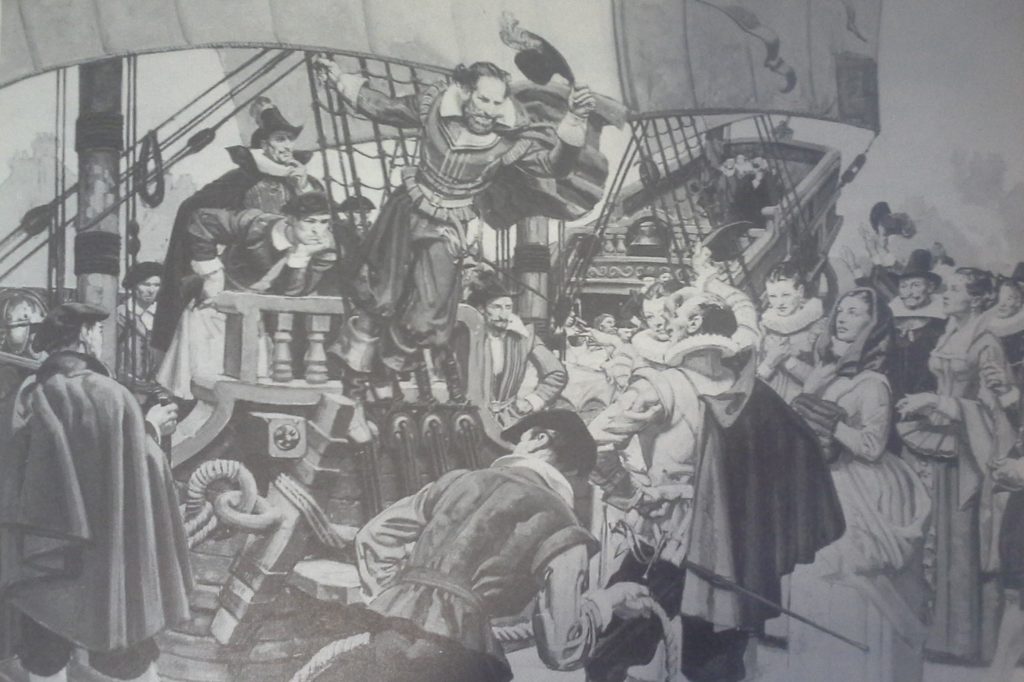
The headquarters of the governor of New France (as the French settlements and posts in North America were called) were in Quebec, on the banks of the St. Lawrence River. That city had been founded in the early 1600’s by Samuel de Champlain. Even to this day Quebec is more French-Canadian than it is English-Canadian. There are newspapers in French, radio broadcasts in French and you hear as much French as English spoken on the streets.
Only French Catholics were welcome in New France. New France exceeded British America in area but not in population. French farmers settled in the St. Lawrence Valley and in Acadia (Nova Scotia). A few traders lived in the region of Louisiana near the mouth of the Mississippi River. But in the vast region between Louisiana and the St. Lawrence Valley there were only scattered Indian tribes, a few French missionaries and some French trappers and traders. In general the French and Indians got along well together. English settlers and the Indians, on the other hand, were often at war.
You may wonder why the French did not go to French America in greater numbers. The French government allowed none but Frenchmen who were Catholics in the colony. Contrast this restriction with the English attitude. The British government cared little about a settler’s religious ideas, nationality, or racial group. Scots, Irish, Germans, Dutch, Swedes, jews and even French were welcome.
4. How Did Overseas Possessions Affect Europe?
History has pointed out the far-reaching changes brought about in distant or hitherto unknown regions of the world by the age of discovery and colonization, but this movement also had important effects on Europe itself.
Europeans became familiar with many new products. No doubt you have heard of the “Irish potato.” The fact is that the potato was a New World product which explorers introduced to Europe. Potatoes later became an important crop in all of western Europe as well as Ireland. This is only one example of a New World product that became popular in Europe. Indian corn (maize), tobacco and chocolate are other New World products that were introduced into Europe during the years of exploration and settlement.
Europeans also enjoyed larger supplies of other products. These included coffee, sugar, molasses (from which distillers make rum), rice, cotton, indigo and brazilwood (used for dyes). There was also lumber of many kinds — from the ebony and mahogany of the tropics to the soft pine and hard oak of the New England forests. Furs from North America became much-sought items in Europe’s luxury trade. From the Far East came silks, Oriental rugs, teas and spices. All these goods meant more comforts and higher living standards for many people in Europe.
Other far-reaching changes occurred in Europe. One of the many changes taking place in Europe was the growth of powerful trading companies, already mentioned. As trade increased and colonies developed, certain things were needed — ships to transport settlers, carry goods and products, to exchange for the raw materials of the colonies. Towns increased in size and cities such as London, Paris and Amsterdam became important centres of manufacturing and trade. We must remember, however, that goods were not produced in huge factories with long assembly lines. Instead, manufacturing took place in small shops where a few craftsmen worked, or in homes where the work was “put out” to members of the family.
The increased activity in trade and industry required money. Banks were established to provide money for business ventures and as places in which to deposit profits. Insurance companies helped to reduce the risks which merchants and businessmen had to take. Merchants, bankers and businessmen made up a middle class which grew rapidly in numbers and influence, offsetting the power of nobles, landowners and churchmen.
By about 1500, as we have seen, the old feudal system was declining and feudal nobles had lost much of their power. Kings who had gradually gained broader powers united their peoples into the national groups that we think of today as the countries of Europe. Five of these countries — Spain, Portugal, Holland, France and England — were among the leaders in the rush for overseas possessions and markets.
During the years of exploration and colonial expansion, European goods and customs were carried to distant parts of the world. In turn, Europeans, who for a thousand years had busied themselves with internal quarrels, gained a new out look. Control of foreign resources, peoples and lands became important to them. So commenced a struggle, which has lasted up to recent times, for control of other lands and other peoples. What we call imperialism, that is, the control of distant resources, markets and peoples, had begun.
